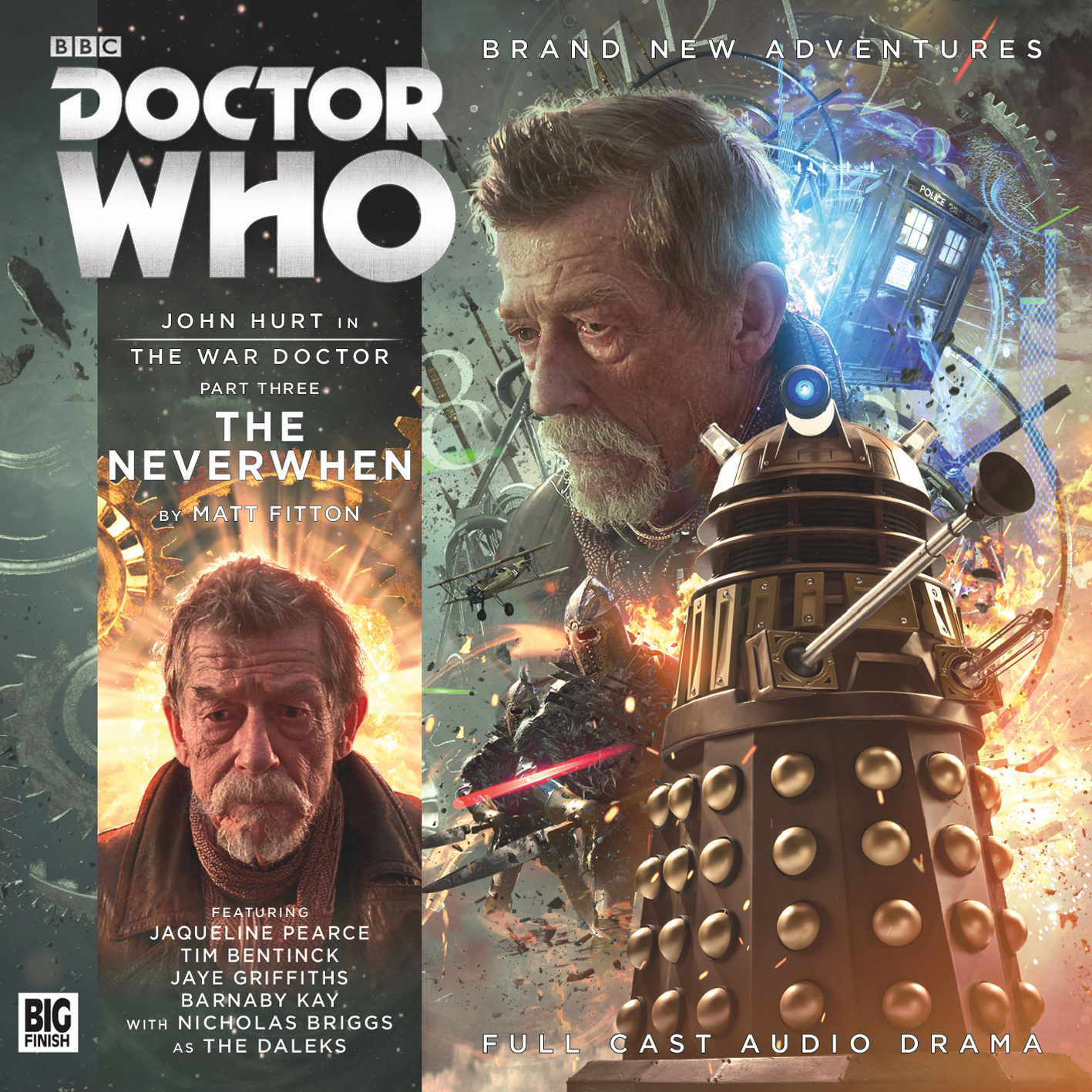Doctor Who - The War Doctor - Vol 2: Infernal Devices
Written by John Dorney, Phil Mulryne and Matt Fitton
Directed by Nicholas Briggs
Big Finish Productions, 2016
Stars: John Hurt (The War Doctor), Jacqueline Pearce (Cardinal Ollistra), David Warner (Shadovar), Jamie Newall (Co-ordinator Jarad), Zoë Tapper (Collis), Robert Hands (Captain Solex), Oliver Dimsdale (Commander Trelon), Laura Harding (Navigator Valis), Barnaby Kay (Commander Thrakken), Jaye Griffiths (Daylin), Tim Bentinck (General Kallix), Tracy Wiles (Commander Barnac), Nicholas Briggs (The Daleks)
If any single thing could be considered Gallifrey’s deadliest weapon – and greatest hope – then it’s him!
Cardinal Ollistra
After the tour de force that was Only the Monstrous, the first volume of Doctor Who – The War Doctor adventures, the second – Infernal Devices – has some rather large shoes to fill. Whereas the first volume was an epic story told over three one-hour discs (and which had sufficient time to establish and develop its characters and concepts), Infernal Devices is more of an anthology of three distinct one-hour episodes, told by separate writers.
Nevertheless, the three tales contain linking material that comes to a head in the final instalment – again emphasising just how desperate the Time Lords, and particularly the shrewd, calculating Cardinal Ollistra (again colourfully portrayed by Blake’s 7 veteran Jacqueline Pearce), are to seize victory in the Time War, even though such triumph may come at too high a price.
Each of the three tales are entertaining and thought-provoking enough. They land the Time Lord formerly known as the Doctor (“I’ve told you, Cardinal, no one answering to that name here!”) – played brilliantly by the incomparable Sir John Hurt – in a series of inescapable moral quandaries that sow the seeds for the tortured, embittered incarnations that come after him. Hurt’s agonising responses to these dilemmas also illustrate that as much as the War Doctor would like everyone to believe that the Doctor is long gone, there is still more of that persona under the War Doctor’s hardened exterior than even he acknowledges. Other characters recognise that, including Ollistra, who wilfully exploits it.
Boxset opener The Legion of the Lost is an effort by writer John Dorney to tell a Time War-era story that doesn’t specifically involve the Daleks. While Dorney sets out to be original, the story itself is mostly dull and its main antagonists abstract and uninteresting. Even the commanding performance of the excellent David Warner as the sinister, humourless Shadovar cannot paper over the shortcomings of an ordinary story.
A Thing of Guile, while entertaining and thought-provoking in parts, is probably the weakest link in the anthology. As its author Phil Mulryne mentions in the CD extras, the story draws on hints and scuttlebutt about the Time War gleaned from David Tennant’s era of Doctor Who. Certainly, the “weapon” the War Doctor and Ollistra encounter in A Thing of Guile is clearly inspired by Tennant era two-parter Daleks in Manhattan/Evolution of the Daleks. However, the core idea is so quickly disposed of that it fails to have emotional impact. Even the climax to the tale – in which the Doctor and Ollistra outwit a Dalek fleet, surely no mean feat – is all too conveniently solved by a deus ex machina and is virtually a carbon copy of the climax to the recent Seventh Doctor/Dalek tale We are the Daleks (a more superior, inventive Dalek tale).
The Neverwhen is the best of the three stories in the boxset. Script editor Matt Fitton’s central idea would be ingenious if it hadn’t unfortunately been surpassed by Heaven Sent, the penultimate episode of Peter Capaldi’s second TV series. While the nightmarish recurring scenario presented in The Neverwhen is very different to the 12th Doctor’s predicament in Heaven Sent, and certainly not as personal for the War Doctor, it is definitely personal and painful for each of the Time Lord/Gallifreyan and Dalek/Kaled soldiers caught in the crossfire.

Indeed, in contradiction of their efforts to rejuvenate their forces, the Time Lords demonstrate a cavalier disregard of their own numbers. Collis (Zoë Tapper) bemoans at the beginning of Legion that she won’t be missed on Gallifrey because she was only a lowly clerk before being pressed into service as a soldier. In A Thing of Guile, Co-ordinator Jarad (Jamie Newell) proves equally as out of his depth when he accompanies Ollistra and the Doctor to a Dalek-controlled asteroid; the Doctor describes him as a “penpusher” who should never have been in the line of fire. Even Jarad’s offsider, Chancellery Guard captain Solex (Robert Hands), discovers he is not as battle-hardened as he thinks he is. Ollistra also demonstrates a patent disregard and manipulation of the Gallifreyan battalions stranded in the Neverwhen, giving the troops hope when she knows there is none.
“You do not have the authority!”
“I don’t need authority – I have a [sonic] screwdriver!”
Co-ordinator Jarad and the War Doctor
The boxset also brilliantly portrays the strained relationship between the Doctor and his own people. It is clear across this boxset (it was hinted on TV in The Day of the Doctor and was more subtle in Only the Monstrous) that, much like his other incarnations, the War Doctor is a maverick Time Lord. In the Time War, he proves as much a thorn in his people’s proverbials as the Daleks. Hurt’s Doctor sticks his nose up at authority, wherever and whenever he can, for the good of races that are likely to be collateral. When he appears in the opening moments of The Legion of the Lost, alongside Collis, it is quickly established that the Doctor is there to destroy an ancient temporal weapon that has fallen into Dalek suckers, not to claim it for the Time Lord High Council. As a result of his intervention, the Doctor is later arrested by Cardinal Ollistra as a war criminal and declared Prisoner 101 (in a none too subtle compliment, I suspect, to Hurt’s brilliant portrayal of Winston Smith in the feature film adaptation of George Orwell’s Nineteen Eighty-Four).
While the Doctor may have been a nuisance and embarrassment in the past to his people (especially the “Ravalox incident” in The Trial of a Time Lord), that was in a period of supposed non-intervention. With the Time Lords now actively engaged in war, they can clearly no longer countenance the Doctor being left to his own agenda, as he is effectively robbing them of the strategic advantages they need to win the Time War!
Nevertheless, the War Doctor continues to be a source of admiration and hushed whispers amongst Gallifreyans who have been pushed into wartime service by the High Council. Collis is all too quick to defer to him when she realises his identity and in A Thing of Guile, Trelon (Oliver Dimsdale) is not only in awe of “the Renegade” but grew up on Gallifrey hearing stories about his exploits. Even Solex eventually understands the importance of the Doctor’s role in the war after spending time with him in the field. As intensely disliked as the Doctor is by the High Council, it is clear there is a respect and admiration, even hero worship, of him in the lower levels of the Time Lord hierarchy (which is also reflected in the Season 9 finale of the TV series Hell Bent, when Time Lord soldiers defy Rassilon and throw down their arms rather than execute the 12th Doctor).
The dramatis personae are well cast by Big Finish. Zoë Tapper brings warmth and empathy to the part of Collis, with the modern Survivors TV series star showing off her potential as Doctor Who companion material, while David Warner’s Shadovar dominates every scene he is in. 
The soldiers we also meet in The Neverwhen are also sympathetically portrayed – from the courageous Daylin (Jaye Griffiths, who will be familiar to fans as hapless UNIT operative Jac in The Magician’s Apprentice and The Zygon Invasion) and the cynical Commander Thracken (Barnaby Kay) to the steadfast General Kallix (Tim Bentinick) and his faithful, hopeful underling Commander Barnac (Tracy Wiles). You cannot help but admire them for their tenacity in bleak, impossible circumstances. Oliver Dimsdale also impresses as Trelon, the luckless captain of a Time Lord-acquired deep space miner called The Tempest. Dimsdale’s Mark Sheppard-like voice is distinctive and authoritative in its own right but he also plays an intriguing maverick character for even a lower Time Lord functionary.
Of course, Nicholas Briggs, who takes up the directing chores for this boxset after he wrote Volume 1, continues to steal scenes as the multiple voices of the Daleks. The Dalek threat is not as prominent in Infernal Devices as it was in Only the Monstrous, with the metal meanies almost being incidental to the trilogy. Even though it doesn’t quite pay off, Briggs and Mulryne at least try something inventive with the Daleks in A Thing of Guile. A Dalek scientist’s monologue about the future of the Dalek race, however, just comes across as extremely odd on audio – it’s a valid enough moral to the story but given Daleks are boring conversationalists at the best of times, it’s not entirely plausible!
“Tightening the artron leash hurts me more than it hurts you!”
“I sincerely doubt that!”
“Every time I have to scramble your nerve endings to force compliance, it simply means you haven’t seen my point of view! And that wounds me!”
Cardinal Ollistra and the War Doctor

Nevertheless, while the character didn’t particularly strike me in Only the Monstrous as unusual for a Time Lady and War Council member, I am now convinced after some careful listening of Infernal Devices that perhaps BF has still only scratched the surface with Ollistra. There may still be a big revelation to come about her character. Ollistra's hatred of the Daleks, which she expresses in no uncertain terms in The Neverwhen, seems to stem from a personal vendetta, not simply that her people are at war with the Dalek Empire. Although it’s not corroborated by either the classic or modern incarnations of the Doctor Who TV series, there is only one other character I’m aware of – at least from Big Finish’s corner of the Whoniverse – that has expressed such loathing of the Doctor’s perennial enemies. It implies that Ollistra is more familiar to us than we realise and that the War Doctor is not the only Time Lord to have renounced his or her name in the Time War. This also seems borne out to me when in the climax to the boxset, the Doctor tells Ollistra to look at her “own hearts, see how black they have become”. It’s all speculation on my part, of course, but BF’s confirmation that a fan favourite companion will be guest starring in Volume 4 of The War Doctor saga has only intensified my suspicions …
Regardless of what may happen in Volumes 3 and 4, Infernal Devices is an entertaining and thought-provoking, albeit imperfect and sometimes disappointing addition to BF’s War Doctor saga. Like a curate’s egg, it’s not brilliant but it has memorable moments and ideas. With Volume 3 set to cast some light on how other antagonists are exploiting the Time War for their own ends, I still look forward immensely to BF’s next take on an otherwise fascinating series.







